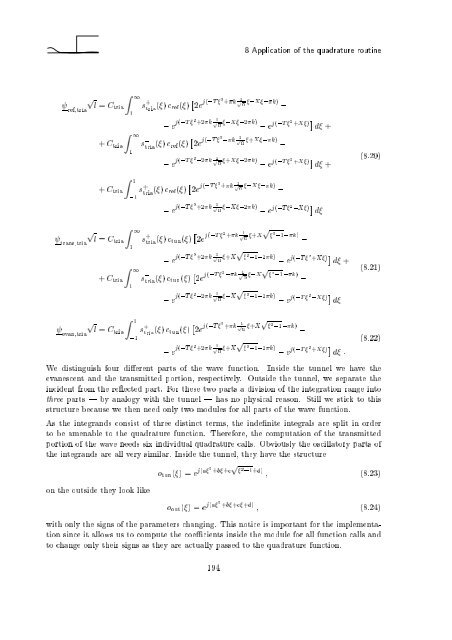Wave Propagation in Linear Media | re-examined
Wave Propagation in Linear Media | re-examined
Wave Propagation in Linear Media | re-examined
You also want an ePaper? Increase the reach of your titles
YUMPU automatically turns print PDFs into web optimized ePapers that Google loves.
ef,tria<br />
trans,tria<br />
evan,tria<br />
p l = Ctria<br />
+ Ctria<br />
+ Ctria<br />
p l = Ctria<br />
+ Ctria<br />
p l = Ctria<br />
Z 1<br />
1<br />
Z 1<br />
1<br />
Z 1<br />
,1<br />
Z 1<br />
1<br />
Z 1<br />
1<br />
Z 1<br />
,1<br />
s +<br />
tria ( ) c<strong>re</strong>f( ) 2e j(,T 2 + k 1<br />
p ,X , k)<br />
,<br />
8 Application of the quadratu<strong>re</strong> rout<strong>in</strong>e<br />
, e j(,T 2 +2 k 1<br />
p ,X ,2 k) , e j(,T 2 +X ) d +<br />
s , tria ( ) c<strong>re</strong>f( ) 2e j(,T 2 , k 1<br />
p +X , k) ,<br />
, e j(,T 2 ,2 k 1<br />
p +X ,2 k) , e j(,T 2 +X ) d +<br />
s +<br />
tria ( ) c<strong>re</strong>f( ) 2e j(,T 2 + k 1<br />
p ,X , k)<br />
,<br />
, e j(,T 2 +2 k 1<br />
p ,X ,2 k) , e j(,T 2 ,X ) d<br />
s +<br />
tria ( ) ctun( ) 2e j(,T 2 + k 1<br />
p<br />
p +X 2,1, k)<br />
,<br />
, e j(,T 2 +2 k 1<br />
p +X<br />
s , tria ( ) ctun( ) 2e j(,T 2 , k 1<br />
p ,X<br />
p 2,1,2 k) , e j(,T 2 +X ) d +<br />
p 2,1, k) ,<br />
, e j(,T 2 ,2 k 1<br />
p<br />
p ,X 2,1,2 k) j(,T<br />
, e 2 ,X )<br />
d<br />
s +<br />
tria ( ) ctun( ) 2e j(,T 2 + k 1<br />
p<br />
p +X 2,1, k)<br />
,<br />
, e j(,T 2 +2 k 1<br />
p +X<br />
p 2,1,2 k) , e j(,T 2 +X ) d :<br />
(8.20)<br />
(8.21)<br />
(8.22)<br />
We dist<strong>in</strong>guish four di e<strong>re</strong>nt parts of the wave function. Inside the tunnel we have the<br />
evanescent and the transmitted portion, <strong>re</strong>spectively. Outside the tunnel, we separate the<br />
<strong>in</strong>cident from the <strong>re</strong> ected part. For these two parts a division of the <strong>in</strong>tegration range <strong>in</strong>to<br />
th<strong>re</strong>e parts | by analogy with the tunnel | has no physical <strong>re</strong>ason. Still we stick to this<br />
structu<strong>re</strong> because we then need only two modules for all parts of the wave function.<br />
As the <strong>in</strong>tegrands consist of th<strong>re</strong>e dist<strong>in</strong>ct terms, the <strong>in</strong>de nite <strong>in</strong>tegrals a<strong>re</strong> split <strong>in</strong> order<br />
to be amenable to the quadratu<strong>re</strong> function. The<strong>re</strong>fo<strong>re</strong>, the computation of the transmitted<br />
portion of the wave needs six <strong>in</strong>dividual quadratu<strong>re</strong> calls. Obviously the oscillatory parts of<br />
the <strong>in</strong>tegrands a<strong>re</strong> all very similar. Inside the tunnel, they have the structu<strong>re</strong><br />
otun( )=e j(a2 p<br />
+b +c 2,1+d)<br />
; (8.23)<br />
on the outside they look like<br />
oout( )=e j(a 2 +b +c +d) ; (8.24)<br />
with only the signs of the parameters chang<strong>in</strong>g. This notice is important for the implementation<br />
s<strong>in</strong>ce it allows us to compute the coe cients <strong>in</strong>side the module for all function calls and<br />
to change only their signs as they a<strong>re</strong> actually passed to the quadratu<strong>re</strong> function.<br />
194












